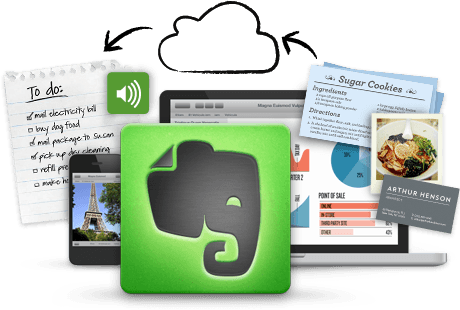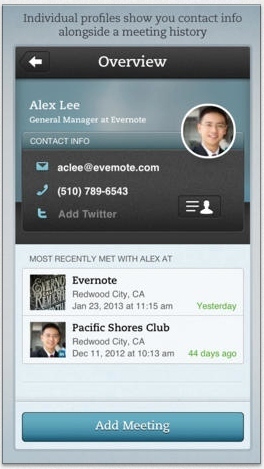It’s no secret that I’m a big fan of Evernote, the web service with mobile and computer software for recording everything. I’ve been using it for about six years now and it really has become my second brain, storing everything from receipts to articles clipped from the web to every social media update I post.
Here are some of the ways I use Evernote. I won’t claim to be using it the most efficiently or that there’s some secret mojo here, but maybe I can give some ideas to others.
1. Your secret email address
Every Evernote account comes with a unique secret email address and anything sent to that address gets saved to your notebooks. I often add it as a BCC for emails to people with whom I’m working on a project.[1] Or I forward emails to it that I want to save like receipts or emails about projects.
2. Keep your Inbox at the top
When you set up Evernote you specify a default notebook where notes that don’t have a designated notebook end up. I choose to name mine Inbox, but I go further by putting ‘@’ before Inbox so that it sorts to the top of any alphabetical listing.
3. Takeout history
I have a notebook called Takeout Orders that I share with Melanie. Whenever we order takeout from someplace, this is where I record our order. On the one hand, it’s a handy place to jot down what we want and if I’m picking up the order I can refer to Evernote on my phone to make sure we got everything. But it’s also very handy as a record of what we’ve got so that when Melanie says, “What did I get last time that I really liked?”, I can just read it off to her. It’s also a record of how often and the last time we ordered from any particular place.
I also use this notebook to store scanned takeout menus as well as the receipts for our favorite Chinese restaurant’s reward points system so we know if we can get that free appetizer this time.
4. Appliance manuals
We used to have a file cabinet drawer nearly full of product manuals for every appliance and consumer electronics device and other products we owned[2], but it was an undisciplined mess and a waste of space. It turns out that with a little Google-fu you can find PDF versions of nearly every product’s manual on the market today, which I download and place in an Evernote notebook cleverly named Product Manuals.
If I can’t find the manual online, I tear it apart and feed it through the document scanner and save it as a PDF.
The bonus is that when I need to consult the manual, I just search Evernote for “manual” and “vacuum” for example and up it comes, whether it’s part of the text I typed or text in an image.
5. IFTTT and Evernote
IFTTT (If This, Then That) is a web service that allows you to connect a variety of other web services in unique ways. I won’t get into too much detail about IFTTT, but I’ve created several Evernote-related “recipes”.
For example, I use the email app Mailbox on my iPhone and iPad to quickly sort through email. When I encounter an email that I want to save to Evernote, I put it in the “Add to Evernote” list, which in my Gmail account is a label called “Add to Evernote”. IFTTT is watching that label and when it sees an email there, it creates a new note in Evernote for it.[3]
Another set of recipes create an archive of all my social media updates. Since you never know when Facebook or Twitter or any of the rest of the social networks will get bought out/disable your account for some spurious reason/experience data loss, etc., you can’t rely on them to keep an historical archive of your pithy bon mots. This is not merely frivolous self-indulgence if you ever find yourself needing to prove exactly what you said and when you said it.[4] So all of my Instagrams, all my Facebook updates, all my tweets, all tweets that I’ve favorited, every Foursquare check-in. Likewise, I can send an RSS feed to Evernote and so every new post on my blog is archived too.
6. Hello and business cards
I don’t get lots of business cards, but I get some and especially when I go to an event like the Catholic New Media Conference or last year’s Catholic Media Conference I end up with lots. In the past, those cards ended up in a drawer and if I later wanted to contact somebody, I had to go digging, but now with Evernote, it’s much more automated.
I like using the Evernote Hello app on my iPhone to quickly enter all the relevant information into the Contacts app, which syncs everywhere, and find other information about the person on social networks. You can either enter the info by hand or better, take a photo of their business card and let the app pull it apart and put it in the appropriate fields. Then it looks to LinkedIn to pull in whatever data wasn’t on the card, including profile photo, to flesh it out.
Hello is also nifty in that it looks at your current location and what’s on your calendar right now to associate the contact within a context. For example, if you’ve put a banner on your calendar that you’re at XYZ Conference and the phone locates you at the Convention Center in Anytown, then Hello will make a note on your contact that effect, helping you remember later where you met so and so. Even if you don’t scan the cards until you’re back home, you can manually set the location and event.
The contacts also end up in your main Evernote database in a notebook of your choosing, which lets you find them in searches.
7. Tables of contents
If you select a whole bunch of notes in Evernote, you get several options, including an option to create a table of contents. This makes a new note that containts a list of all the notes you’ve selected which are themselves link to the original note. It can be very handy as an index, like in the old days of paper files when a list of the contents of the file would be staped to the inside of the manila folder, for example.
To make this even more useful, click the button to set a reminder on the Table of Contents note (don’t bother setting a notification date) and now a link to the TofC note will be permanently at the top of the notebook list, or at least until you clear the reminder.
8. Reminders don’t have to be dated
Speaking of reminders, I use them as a way to keep active notes sorted at the top of a notebook. I have a notebook I use for planning my radio show’s topics and guests. When I’m still actively working on a show, I set an undated reminder on it so it shows in the special reminders list. Once the show is past or I abandon the topic, I clear the reminder and it’s gone from the list while remaining in its place in the notebook.
9. Public shared notebooks for clients and customers
I have a shared notebook which I use as a repository for web clippings that I want to share with folks who work in Catholic social media at parishes and ministries in the Archdiocese of Boston. I have linked to that notebook on my office’s website. Someday I would like to create a widget that shows the titles of the most recent five items I’ve added to the notebook.
10. Private shared notebooks for family
Melanie and I have a couple of shared notebooks for our household needs. We have one called Shopping that includes several notes for different kinds of shopping lists: groceries, hardware store, clothing, etc. We also put birthday wishlists for the kids in there. Another is called Household ToDo and Wishlist, which holds notes related to various chores that need to be done, projects we’d like to do, articles about home repair and DIY, etc. Either one of us can add to the notes as we see something that needs to be done or we’d like to do.
Another notebook contains various kinds of information about the kids that either of us may need to access, whether it’s clothing sizes or medical information. Still another notebook has all our favorite recipes.
So that’s ten random tips and tricks for Evernote that I use all the time, but there are many more which I may truck out in a follow up post sometime. What are your favorite Evernote tips and tricks?
-
Only BCC (blind carbon copy) as opposed to CC because you want to keep this address secret. Any email sent to this address will end up in your Evernote notebooks. ↩
-
Not to mention quite a few we didn’t own anymore since cleaning out the drawer when we tossed old or broken stuff wasn’t a high priority. ↩
-
I do the same thing for a Mailbox list called “Add to Omnifocus”. Any email put in there gets added to the Omnifocus inbox to become part of my todo list. ↩
-
Unfortunately Twitter has removed the ability for outside services to access what other people tweet so the conversations it records are one-sided. ↩













You’ll want to use the two-factor authentication on Evernote if you are not using it already. Evernote is my *brain* (it even drives my blog), but it’s a lot of personal information to have out there on the cloud without some extra layer of protection. 🙂
That is a good tip, of course. I use two-factor authentication wherever a service offers it.
I like Evernote for its all-in-one nature. However, I have misgivings about essentially having a database in a 3rd party app. Do you worry about ever being able to get your data back out? Your above examples don’t seem to include anything too sensitive, like tax docs. If not, how do you incorporate everything into your paperless workflow?
Hey Josh,
Actually I do put some sensitive documents in there. I guess I just have a lot of confidence in the company. They have stated publicly that they are committed to building a 100-year company, that they’re not looking to pump up the value and sell out, and that they’re committed to making it easy for you to get your data out.
Do you know if Evernote supports Markdown? I know you use it in your workflow. Just wondering how you fit it in to your note-taking via Evernote.
It doesn’t and I believe it’s a common feature request. Right now I take notes in a third-party app, either TextMate on my Mac or Drafts on my iPad, and then move the text to Evernote. Drafts converts the text to Evernote’s RTF, but the TextMate text stays in Markdown format.
For a while I tried taking the notes for The Good Catholic Life directly in Evernote, but it was a bit more difficult than just typing into a text editor like TextMate.
Hi Josh,
You know I forgot, but you can use the third-party app Byword to write in Markdown and then it has a built-in function to publish the note to Evernote. Not the same as typing inside Evernote, but it’s handy nonetheless.
Thanks, Dom. I enjoy reading your workflow posts, as you can tell.
You are amazing, Don! I realize how little I know about current apps when I read something like this. I’m constantly awed at your prolific use of technology. I say this with my highest compliments: you a true geek! 🙂
I have recently created a step by step video tutorial on Evernote that will show you basic to advanced level Evernote strategies and tactics – It’s Free, access it here: http://treptalks.com/evernote